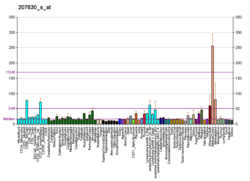Disease relevance of CREM
Panic disorder
One study reported the DNA sequence variations in the gene for CREM in panic disorder patients. It showed a significant excess of the shorter eight-repeat allele and of genotypes containing the eight-repeat allele in panic disorder patients. [16] The observed associations were limited to panic disorder without agoraphobia, and they were more prominent in females. But, the independent Italian and Spanish samples in this study did not support their results. Another family-based study showed little evidence of any susceptibility locus for panic disorder either within the CREM gene or in a nearby region on chromosome 10p11 [17]
Spermiogenesis deficiency
CREM has been shown to be a master-switch regulator in testis. [18] It plays an important role in the regulation of the expression of post-meiotic genes, and this has been supported by several studies using CREM-mutation mice. [19] The results showed the first step in the process of sperm formation would be blocked if the germ cell development in mice CREM gene were disrupted. The cAMP response element sites can be found in the promoter region of some postmeiotic genes, so that the CREM can target and regulate these genes. [18]
Two studies proved that treatment of rats with Salvia hypoleuca and Alpina galanga can significantly increased the CREM gene expression. [20] [21]
Systemic lupus erythematousus
Less IL-2 will be produced from T cells in humans or mice with systemic lupus erythematousus (SLE). Some studies showed that an increased level CREM was presented in the nucleus of T lymphocytes from SLE patients. The CREM bound to the -180 site of the IL-2 promoter to repress its transcription. [22]
This page is based on this
Wikipedia article Text is available under the
CC BY-SA 4.0 license; additional terms may apply.
Images, videos and audio are available under their respective licenses.








